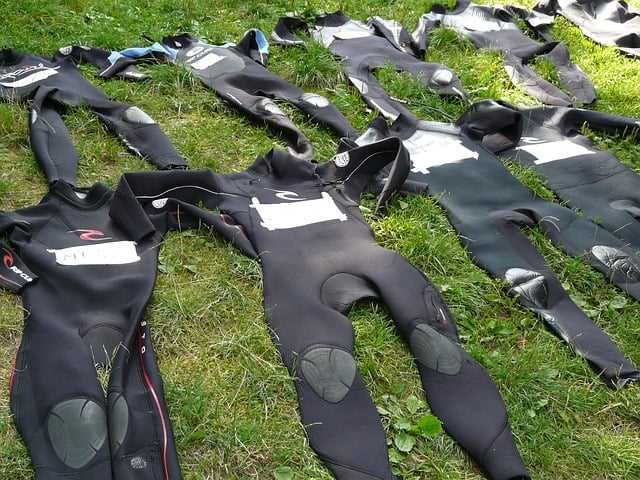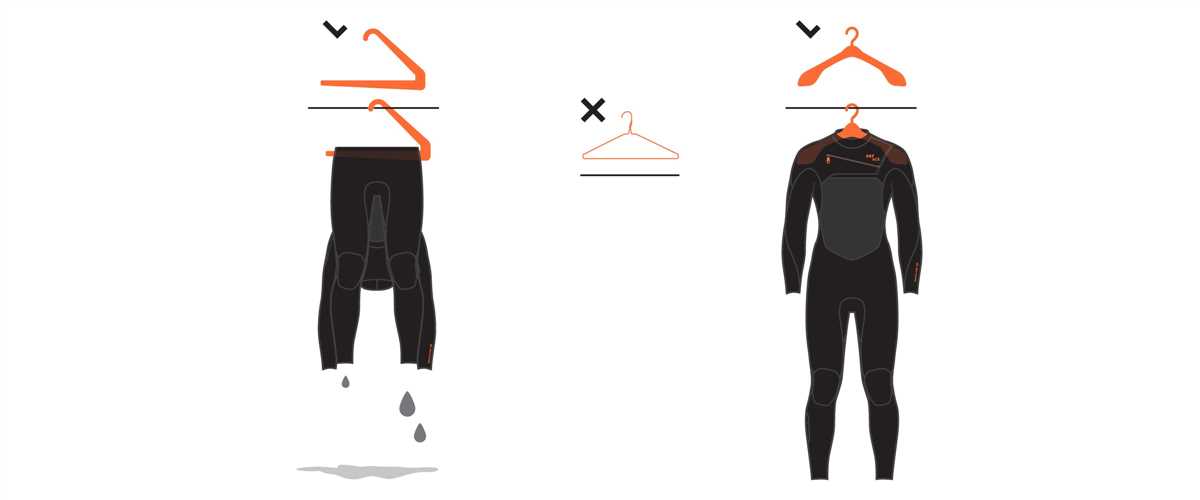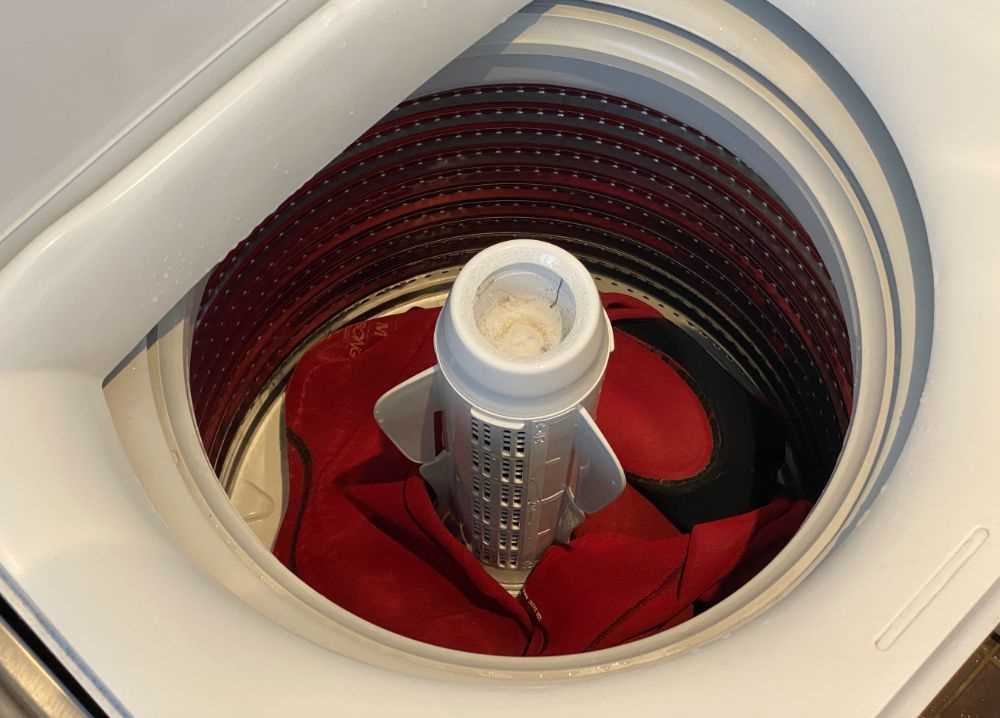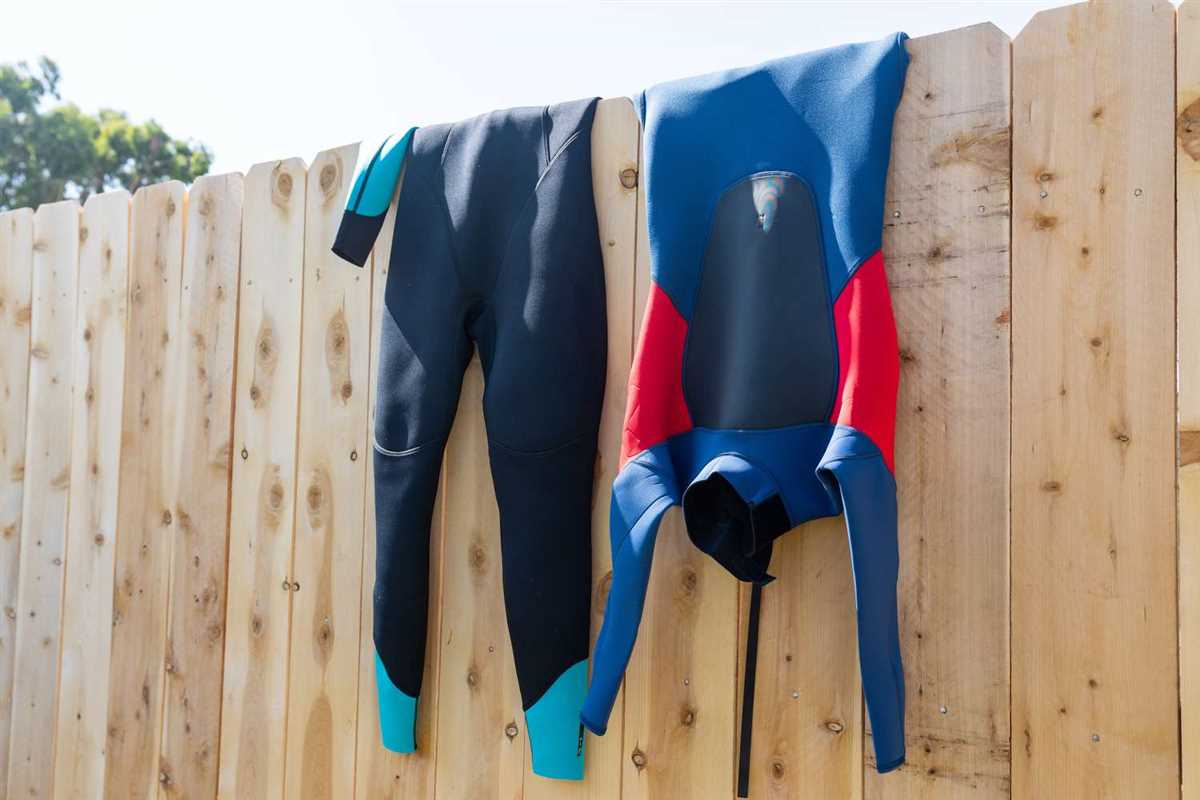




Wetsuits are an essential piece of gear for water enthusiasts who want to stay warm and protected while enjoying their favorite water sports. But after a few uses, wetsuits can start to smell and become dirty. So, can you put wetsuits in the washing machine to clean them? The answer is yes, but there are some important dos and don’ts to keep in mind.
Do:
1. Use a gentle cycle and cold water: When washing your wetsuit in the machine, it’s crucial to use a gentle cycle and cold water. This will help protect the neoprene material and prevent any damage.
2. Use a mild detergent: Choose a mild detergent specifically designed for wetsuits or a gentle soap. Avoid using any harsh chemicals or bleach, as they can deteriorate the fabric and affect its performance.
3. Rinse thoroughly: After washing, make sure to rinse your wetsuit thoroughly to remove any soap residue. Soap left on the suit can cause skin irritation and affect the suit’s buoyancy and flexibility.
Don’t:
1. Use a dryer: It might be tempting to speed up the drying process by using a dryer, but this is a big don’t. The heat from the dryer can damage the neoprene and cause the suit to shrink. Instead, hang your wetsuit to air dry in a shady, well-ventilated area.
2. Use hot water: Hot water can also damage the neoprene material, causing it to become brittle and lose its flexibility. Stick to cold water for washing your wetsuit.
3. Scrub vigorously: While it’s important to clean your wetsuit thoroughly, avoid scrubbing it too vigorously. Harsh scrubbing can weaken the seams and stretch the fabric, affecting the suit’s integrity.
By following these dos and don’ts, you can keep your wetsuit clean and in good condition, ensuring a comfortable and enjoyable experience the next time you hit the water.
Can You Put Wetsuits in the Washing Machine?
Wetsuits are essential gear for water sports enthusiasts and are designed to keep the body warm in cold water. After frequent use, wetsuits can accumulate dirt, sweat, and other residues, leading to unpleasant odors and reduced functionality. While hand washing is typically recommended, there may be situations where you want to use a washing machine to clean your wetsuit. Here are some dos and don’ts to consider before throwing your wetsuit into the washing machine:
Do:

- Read the manufacturer’s instructions: Before washing your wetsuit, it’s important to check the care instructions provided by the manufacturer. Some wetsuits can be machine washed, while others require hand washing or specific cleaning agents.
- Use a gentle cycle: If your wetsuit is suitable for machine washing, select a gentle or delicate cycle to prevent excessive agitation. High-speed spins and strong detergents can damage the neoprene material of the wetsuit.
- Use a mild detergent: Choose a mild detergent specifically designed for wetsuits or neoprene materials. Harsh chemicals can break down the neoprene and compromise the wetsuit’s performance.
- Wash with similar colors: To avoid color bleeding or staining, it is advisable to wash your wetsuit with similar colors or alone.
Don’t:
- Use hot water: Hot water can shrink and damage the neoprene material of the wetsuit. Always use cold water for machine washing.
- Use fabric softeners: Fabric softeners can leave a residue on the wetsuit, reducing its flexibility and buoyancy. Avoid using fabric softeners during the washing process.
- Use bleach: Bleach can deteriorate the neoprene material and cause discoloration. Never use bleach when washing your wetsuit.
- Overstuff the machine: Overloading the washing machine can lead to inadequate cleaning and potentially damage the wetsuit. Make sure there is enough space for the wetsuit to move freely during the washing cycle.
Remember, machine washing should be used as a last resort for cleaning your wetsuit. Regularly rinsing the wetsuit with fresh water and hanging it to dry after each use can help maintain its cleanliness and extend its lifespan. When in doubt, always refer to the manufacturer’s instructions or consult a professional cleaning service.
Washing Wetsuits: The Dos and Don’ts
Do: Rinse with Fresh Water
After each use, it is important to rinse your wetsuit with fresh water. This helps remove salt, sand, and other debris that can damage the material over time. Use a garden hose or a large basin filled with water to thoroughly rinse all areas of the wetsuit.
Don’t: Use Hot Water

Avoid using hot water when cleaning your wetsuit, as this can cause the neoprene material to warp and lose its shape. Stick to using cool or lukewarm water instead.
Do: Use Mild Detergent
When it comes to cleaning your wetsuit, opt for a mild detergent specifically designed for wetsuits or a gentle soap. Harsh chemicals or strong detergents can damage the neoprene and decrease the lifespan of your wetsuit.
Don’t: Use Bleach or Fabric Softener

Avoid using bleach or fabric softener when washing your wetsuit. These products can weaken the neoprene material and cause it to deteriorate faster.
Do: Hand Wash
Hand washing is the preferred method for cleaning wetsuits. Gently scrub the wetsuit with your hands, paying extra attention to areas prone to dirt and grime buildup, such as the knees and armpits.
Don’t: Use a Washing Machine
It is not recommended to put your wetsuit in a washing machine. The agitator and spinning motion can strain and damage the neoprene material, leading to tears and rips.
Do: Hang to Dry
After rinsing and washing your wetsuit, hang it to dry in a shaded area away from direct sunlight. Avoid using a clothesline with clothespins, as this can put unnecessary strain on the neoprene. Instead, use a wetsuit hanger or lay it flat on a clean surface.
Don’t: Use a Dryer
Never use a dryer to dry your wetsuit. High heat can shrink and warp the neoprene, rendering it useless.
Do: Store Properly
Store your wetsuit in a cool, dry place away from direct sunlight. Avoid folding or creasing the wetsuit to prevent permanent damage to the neoprene material. Using a wetsuit bag or hanging the wetsuit on a padded hanger can help maintain its shape and prolong its lifespan.
Don’t: Leave It Damp
Make sure your wetsuit is completely dry before storing it. Leaving it damp can lead to unpleasant odors, mold, and mildew growth.
Do: Regularly Inspect
Regularly inspect your wetsuit for any signs of wear, tear, or damage. Check for loose seams, holes, or areas where the neoprene is stretched or thinning. Addressing any issues promptly can prevent further damage and extend the life of your wetsuit.
Don’t: Ignore Damage
If you notice any damage to your wetsuit, it is best to repair it as soon as possible. Small tears or holes can be patched up with a neoprene repair kit, while larger or more extensive damage may require professional repair.
Proper Care for Wetsuits: Washing Tips

Wetsuits are an essential piece of gear for water sports enthusiasts, providing insulation and protection against the elements. To ensure their durability and maintain their performance, it’s important to properly care for your wetsuit, including regular washing. Here are some helpful tips on how to wash your wetsuit:
1. Rinse with freshwater after each use
After every use, make sure to rinse your wetsuit thoroughly with freshwater. This will remove any saltwater, sand, or dirt that may have accumulated on the surface. Use a hose or a shower to rinse both the inside and outside of the wetsuit.
2. Use a wetsuit-specific shampoo

Regular household detergents and soaps can be too harsh for wetsuits and may damage the neoprene material. Instead, opt for a wetsuit-specific shampoo or cleaner, which is designed to gently clean and condition the neoprene fabric without causing any damage.
3. Hand wash whenever possible

While some wetsuits may be safe to machine wash, it’s generally recommended to hand wash them to minimize the risk of damage. Fill a sink or basin with cool or lukewarm water and add the wetsuit-specific shampoo. Gently agitate the wetsuit in the water, paying extra attention to any areas with stubborn stains or odors.
4. Avoid using hot water or bleach
Hot water can cause the neoprene to lose its elasticity and shrink, so it’s best to stick to cool or lukewarm water when washing your wetsuit. Similarly, avoid using bleach or any harsh chemicals, as they can degrade the neoprene fabric and potentially weaken the seams.
5. Hang to dry
After washing, hang your wetsuit to dry in a shaded and well-ventilated area. Avoid direct sunlight or high-temperature environments, as they can cause the neoprene to deteriorate. Make sure the wetsuit is fully dry before storing it to prevent the growth of mold or mildew.
6. Store properly when not in use
When your wetsuit is not in use, store it correctly to maintain its shape and prolong its lifespan. Hang it on a padded hanger or lay it flat in a cool and dry place. Avoid folding or crumpling the wetsuit, as this can cause permanent creases or damage the neoprene.
- Rinse with freshwater after each use
- Use a wetsuit-specific shampoo
- Hand wash whenever possible
- Avoid using hot water or bleach
- Hang to dry
- Store properly when not in use
By following these washing tips and taking proper care of your wetsuit, you can ensure it stays clean, odor-free, and in great condition for your next aquatic adventure.
Understanding Wetsuit Material: What You Should Know
When it comes to wetsuits, understanding the material they are made of is crucial. The type of material affects the functionality, durability, and overall performance of your wetsuit. Here are some key things you should know about wetsuit materials:
Neoprene
Neoprene is the most common material used in wetsuits. It is a type of synthetic rubber that provides excellent insulation and flexibility. Neoprene wetsuits come in various thicknesses, measured in millimeters, which determines their suitability for different water temperatures. Thicker neoprene wetsuits are ideal for colder waters, while thinner ones are suitable for warmer conditions.
Seams
Wetsuit seams play a crucial role in preventing water from entering the suit. There are three main types of seams used in wetsuits:
- Flatlock: These seams are commonly found in wetsuits designed for warmer waters. They lay flat against the skin and allow some water to enter, which helps to cool the body.
- Glued and blind-stitched: These seams provide better water resistance compared to flatlock seams. They involve gluing two pieces of neoprene together and then stitching them, resulting in a more watertight seal.
- Taped: Taped seams are the most water-resistant type of seams. They involve gluing and taping the seams from the inside and outside of the wetsuit, creating an extra layer of protection against water entry.
Stretch and Flexibility
One key advantage of neoprene is its stretch and flexibility. A good wetsuit should allow for a full range of motion without feeling restrictive. The neoprene material should stretch easily in all directions, providing a comfortable and snug fit.
Care and Maintenance

Proper care and maintenance can extend the lifespan of your wetsuit. After each use, it is important to rinse your wetsuit with fresh water to remove salt and other contaminants. Avoid exposing your wetsuit to direct sunlight for extended periods as this can damage the neoprene material. It is also important to store your wetsuit flat or hanging to avoid creasing and deformation.
Conclusion
Understanding the material used in your wetsuit is essential for making the right purchase and ensuring its longevity. Neoprene, seams, stretch, and flexibility are all important factors to consider when choosing a wetsuit. With proper care, your wetsuit can provide you with years of reliable performance and comfort in the water.
Common Mistakes with Washing Wetsuits
When it comes to washing wetsuits, there are a few common mistakes that people make. Here are some of the dos and don’ts to keep in mind:
1. Using the wrong detergent

One common mistake is using a regular detergent to wash a wetsuit. Regular detergents can be too harsh and can damage the neoprene material. It is important to use a mild, non-detergent cleaner specifically designed for wetsuits. These cleaners are gentle on the neoprene while effectively removing dirt and odor.
2. Using hot water
Another mistake is using hot water to wash a wetsuit. Hot water can cause the neoprene to lose its elasticity and degrade over time. It is best to use cool or lukewarm water when washing a wetsuit.
3. Using a washing machine
While it might be tempting to throw your wetsuit in the washing machine for a quick clean, this is a big no-no. The agitator in the washing machine can damage the neoprene material, and the spinning motion can cause the wetsuit to twist and stretch out of shape. It is best to hand wash your wetsuit gently.
4. Using a dryer
Just like with the washing machine, using a dryer to dry your wetsuit is a mistake. The heat from the dryer can damage the neoprene and cause it to lose its elasticity. It is best to hang your wetsuit to air dry in a shady and well-ventilated area.
5. Not rinsing thoroughly
After washing your wetsuit, it is important to rinse it thoroughly to remove any leftover cleaning solution. Failing to rinse the wetsuit properly can leave behind residue that can irritate the skin or cause damage to the neoprene material.
6. Using excessive force
When washing your wetsuit, avoid using excessive force or rough scrubbing. This can cause unnecessary wear and tear on the neoprene and seams. Instead, gently agitate the wetsuit with your hands to remove dirt or debris.
7. Storing a wet wetsuit
Finally, one common mistake is storing a wet wetsuit without properly drying it first. Storing a wet wetsuit can lead to the growth of mold and mildew, which can cause unpleasant odors and damage the neoprene. Always make sure to thoroughly dry your wetsuit before storing it.
By avoiding these common mistakes, you can ensure that your wetsuit remains in good condition and lasts for many surf seasons to come.
Alternative Methods for Cleaning Wetsuits
While washing your wetsuit in a washing machine is not recommended, there are alternative methods you can use to clean your wetsuit effectively:
1. Soaking in a Tub
One option is to fill a tub with lukewarm water and add a wetsuit cleaner or mild detergent. Submerge your wetsuit completely and agitate it gently to ensure that the cleaning solution reaches all areas. Let it soak for about 15-20 minutes, then rinse thoroughly with fresh water.
2. Handwashing

If you prefer a more hands-on approach, you can handwash your wetsuit using a gentle cleaning solution. Fill a basin or sink with lukewarm water and add the cleaning solution. Gently wash the wetsuit, paying extra attention to any areas with dirt or stains. Rinse thoroughly with fresh water afterward.
3. Spot Cleaning

If your wetsuit only has a few small spots or stains, you can spot clean them instead of washing the entire suit. Use a wetsuit cleaner or mild detergent and a soft brush or cloth to gently scrub the affected area. Rinse with fresh water and make sure the spot is completely clean before allowing it to dry.
4. Hang Drying
After cleaning your wetsuit, it’s important to hang it properly for drying. Use a wide and sturdy hanger or a dedicated wetsuit hanger to avoid stretching the material. Hang it in a well-ventilated area away from direct sunlight to prevent damage to the neoprene. Make sure the wetsuit is completely dry before storing it.
5. Cleaning Products to Avoid
When cleaning your wetsuit, it’s important to avoid using harsh chemicals, bleach, or fabric softeners. These can deteriorate the neoprene material and affect the wetsuit’s performance. Stick to wetsuit-specific cleaners or mild detergents specifically designed for neoprene garments.
Using these alternative methods and taking proper care of your wetsuit will help prolong its lifespan and ensure optimal performance in the water.
FAQ
Is it safe to put wetsuits in the washing machine?
Yes, it is generally safe to put wetsuits in the washing machine, as long as you follow some guidelines.
What are the dos and don’ts when washing wetsuits in the machine?
When washing wetsuits in the machine, do use a gentle cycle, cold water, and a mild detergent. Don’t use bleach, fabric softener, or hot water, and avoid using the dryer.
Can I use bleach to wash my wetsuit?
No, you should not use bleach to wash your wetsuit. Bleach can damage the neoprene material and weaken the seams of the wetsuit.
Is it necessary to use a specific detergent to wash wetsuits?
It is not necessary to use a specific detergent to wash wetsuits. However, it is recommended to use a mild, non-abrasive detergent to avoid any damage to the wetsuit material.
What should I do if my wetsuit has stubborn stains?
If your wetsuit has stubborn stains, you can try spot cleaning the stains with a mild detergent or use a wetsuit-specific cleaner. Avoid scrubbing too hard to prevent damage to the neoprene material.











